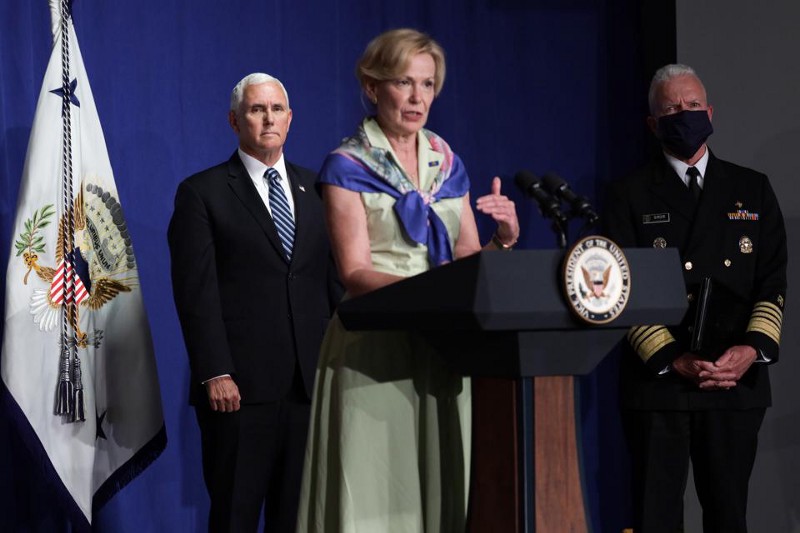How do you turn a country into a scientific powerhouse? Fund basic science.

- How does a country become a scientific powerhouse?
- In 1945 Vannevar Bush, the director of the U.S. Office of Scientific Research and Development, offered an answer to that question through a visionary report to former President Harry Truman.
- Bush’s message was simple: Everything begins with basic science. Let’s hope we don’t forget this essential message.
In July 1945, a month before the U.S. would drop two atomic bombs on Japan, Vannevar Bush, director of the Office of Scientific Research and Development, delivered a report about the future of scientific research to President Harry Truman. The report, Science, the Endless Frontier, had been requested by Truman’s predecessor, Franklin D. Roosevelt. The 32nd U.S. president firmly believed in the power of the mind to wage war against humanity’s foes, either in wars against nations or against disease.
“New frontiers of the mind are before us,” Roosevelt wrote to Bush, “and if they are pioneered with the same vision, boldness, and drive with which we have waged this war we can create a fuller and more fruitful employment and a fuller and more fruitful life.”
Creating scientific capital
Bush opened his report with an eloquent defense of basic science:
“Progress in the war against disease depends upon a flow of new scientific knowledge. New products, new industries, and more jobs require continuous additions to knowledge of the laws of nature, and the application of that knowledge to practical purposes. Similarly, our defense against aggression demands new knowledge so that we can develop new and improved weapons. This essential, new knowledge can be obtained only through basic scientific research.”
This emphasis on research was no doubt inspired by the tremendous success of applied physics in the development of weapons, from more effective cannons, airplanes, and radar, to the invention of the atomic bomb. To these men it was clear that science had won the war. It was equally obvious that the country that obtains the most advanced technology will be the most powerful nation in the world, and that such technology was the fruit of basic scientific research, be it in physics, chemistry, or biology. This is essential: In times of war and peace alike, it is basic science that advances society, as discoveries become innovative technologies.
Bush continued:
“We want plenty of new, vigorous enterprises. But new products and processes are not born full-grown. They are founded on new principles and new conceptions which in turn result from basic scientific research. Basic scientific research is scientific capital.”
This is an essential point. The government must fund research in academia and research institutes so that new scientific results are generated through basic science. These results translate into new technologies, generating jobs and boosting the economy. For any of this to work, we need vigorous and rigorous training of scientific personnel. In Bush’s vision, the country hosting the best scientists to carry out basic research would lead the world. Bush understood that human capital was essential for success:
“How do we increase this scientific capital? First, we must have plenty of men and women trained in science, for upon them depends both the creation of new knowledge and its application to practical purposes. Second, we must strengthen the centers of basic research which are principally the colleges, universities, and research institutes. These institutions provide the environment which is most conducive to the creation of new scientific knowledge and least under pressure for immediate, tangible results. With some notable exceptions, most research in industry and Government involves application of existing scientific knowledge to practical problems. It is only the colleges, universities, and a few research institutes that devote most of their research efforts to expanding the frontiers of knowledge.”
Good science takes time
Scientific institutions should ideally be “the least under pressure for immediate, tangible results,” according to Bush’s aspiration. Scientists could then develop new scientific knowledge without monetary pressures from industry. To coordinate these efforts, Bush recommended “a new agency for these purposes be established.” The National Science Foundation was created in 1950, largely as a response to Bush’s vision and Truman’s support. Bush also had a vision of inclusivity:
“Studies clearly show that there are talented individuals in every part of the population, but with few exceptions, those without the means of buying higher education go without it. If ability, and not the circumstance of family fortune, determines who shall receive higher education in science, then we shall be assured of constantly improving quality at every level of scientific activity. The Government should provide a reasonable number of undergraduate scholarships and graduate fellowships in order to develop scientific talent in American youth.”
Despite the war-like tone and interest in national security, Bush’s vision remains an inspiration to this day, even if the realities of basic research and its funding have changed. Indeed, they now include huge corporate research centers that hire top-notch scientists and engineers to develop their own products based on basic research. Take as an example Google and Amazon’s efforts in quantum computing. This, of course, is not new. Past examples include Bell Labs, Xerox, and Kodak, among many others.
The partnership with the government continues, but it is now broadened to include private initiatives and industries, with universities bridging their own faculty to outside investors. Private foundations, through their philanthropic initiatives, play an ever-increasing role as well, especially in funding projects that government agencies consider too risky. This is also not new. The history of big telescopes in the U.S., for instance, owes much to private entrepreneurs. But the trend is growing. Examples include the checkered funding history of the Search for Extraterrestrial Intelligence, as well as support for more abstract or philosophical aspects of fundamental research in the natural sciences — the type of research funded, for example, by the John Templeton Foundation. The field is crowded and enthusiasm grows every day.
Freedom to create
Bush’s vision of scientific research as a nation’s essential gate to economic power remains as true as ever. In our century, scientific leadership is a cornerstone of national competition. Countries that do not invest in basic science, and that fail to train highly skilled scientists, will fall behind.
Creative freedom, Bush understood, is essential:
“Scientific progress on a broad front results from the free play of free intellects, working on subjects of their own choice, in the manner dictated by their curiosity for exploration of the unknown. Freedom of inquiry must be preserved under any plan for Government support of science.”
Bush’s vision, born at the end of a devastating war, still resonates strongly. Science will not solve all our problems. But given funds and a chance, scientists will try.





